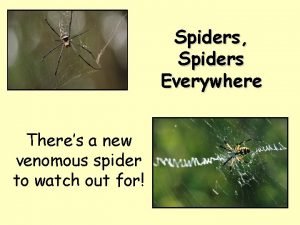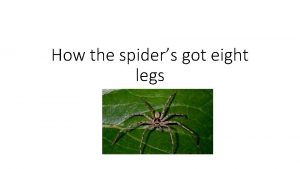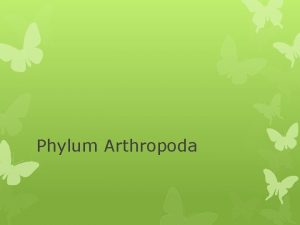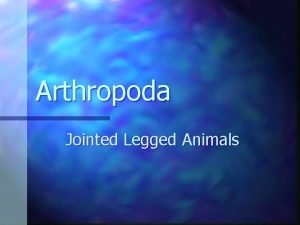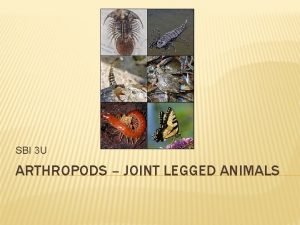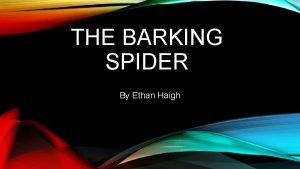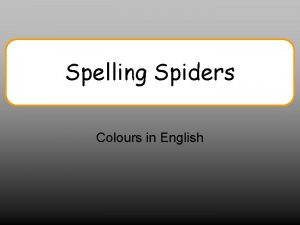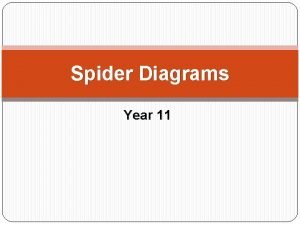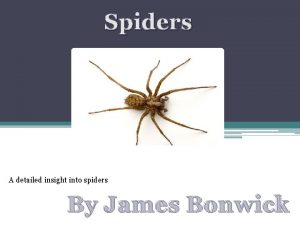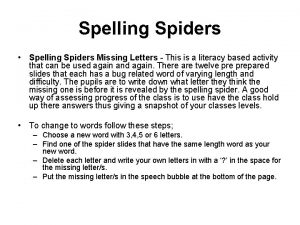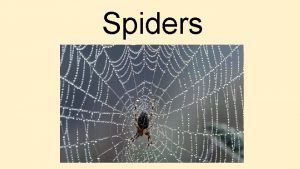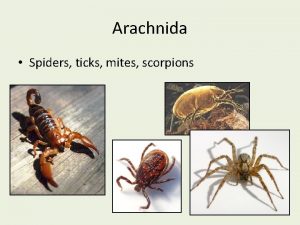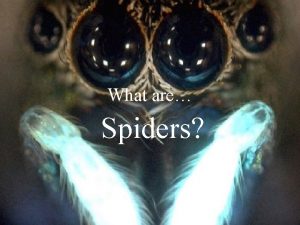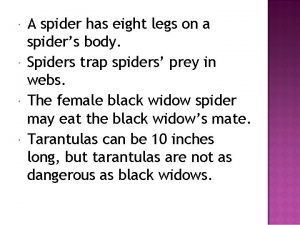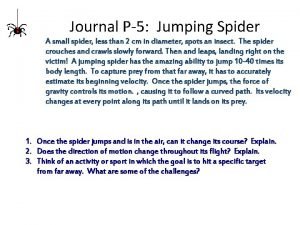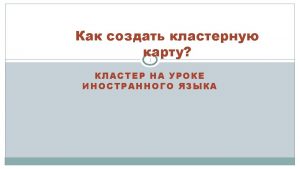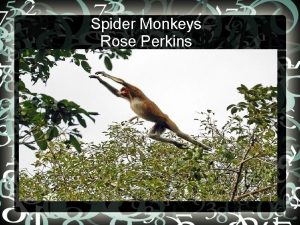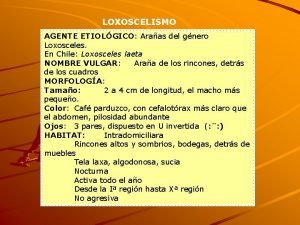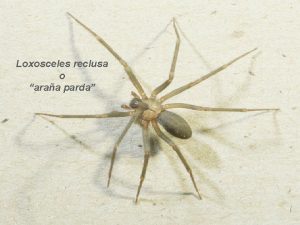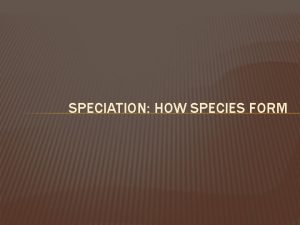The Demistifying Spider Species of Spiders Loxosceles Heineken


































- Slides: 34

The Demistifying Spider

Species of Spiders Loxosceles Heineken or Recluse Spider

Species of Spiders Cheiracantiu m mildei or Yellow-sac Spider

Species of Spiders Aranha armadeira or Banana Spider (Phoneutria)

Species of Spiders Lampona cylindrata or White-tailed Spider

Species of Spiders Latrodectus hasselti or Black Widow

Species of Spiders Dysdera crocata or Dysdera spider

Species of Spiders Atrax robustus or Sydney. Funnel Web Spider

Location of Spider Toxins

SPECIFIC GENUS OF SPIDERS AND THEIR TOXINS AND ITS AFFECT


CHEMISTRY OF SPIDER VENOM Three main groups of toxic compounds: • Low Mr polyamines (Mr less than 1000) • Polypeptides (Mr 3000 -10, 000) • High Mr proteins (Mr more than 10, 000)


Other venom components are: • • inorganic ions and salts free acids (eg. lactic acid) glucose nucleic acids They are believed to aid the stability, delivery and effectiveness of the toxins.

Polyamines It is consists of a hydrophobic, aromatic carboxylic acid region connected to a hydrophilic polyamine amide chain.


• It works by blocking neuromuscular junctions in insects to prevent the release of the main neurotransmitter, glutamate, resulting in paralysis. • These toxins tend to be specific for insects and not vertebrates.

Polypeptides • Ion channels are proteins situated on the nerve cell membrane. Toxins block the channels that control the electrical potential of the membrane and ionic balance so they are vital in neurotransmitter release.

Calcium channels

– important in cardiac and muscular function – blocked by -agatoxins (30 -40 amino acid peptides) – causes muscular paralysis due to prevention of neurotransmitter release

Sodium channels – Present in nerve and muscle. – Targeted by -agatoxins (36 -37 amino acid peptides) – Increase the amount of Na+ moving across the cell membrane to cause excessive presynaptic neural stimulation and massive neurotransmitter release.

– Causes hyperstimulation of post-synaptic receptors resulting in paralysis mainly by by -atracotoxins – Comes from the Australian funnel-web spiders Atrax robustus and. Hadronyche versutus which show significant toxicity towards humans.

Potassium channels – Influence cardiac function – Targeted by hanatoxins (35 amino acids) • Works together with sodium channel toxins to induce massive neurotransmitter release and paralysis.

‘CYSTEINE KNOT’


Combinatorics of disulfidecontaining peptides in spider venom (example of Chilobrachys jingzhao)


Combinatorics of disulfidecontaining peptides in spider venom (example of Agelena orientalis)


Proteins alpha-latrotoxin - neurotoxic protein from the black widow spider. • highly toxic to vertebrates and causes massive neurotransmitter release. sphingomyelinase D – enzyme proteins from brown recluse spider • causes necrotoxin • degradation of cell membranes and the development of painful lesions.

SAFETY RULES • Do not leave clothes, shoes, towels, etc. on the floor • Check shoes before putting them on • Do not walk about at night without footwear • Do not handle spiders that appear to have drowned in pools, buckets, etc. • Wear gloves when gardening or working outside

FIRST AID • Keep the bite victim calm and immobile. • For a funnel-web bite, apply a pressureimmobilization bandage to the bite site and the adjacent limb. For example, a bite on the finger should be treated by bandaging the entire arm. Further restrict movement by applying a splint.

• For a red-back bite, the only first aid required is the application of an ice pack to the bite site to reduce the pain. • Seek emergency medical assistance immediately.

Thanks for Listening (the original copy was lost so this has no animation)
 Loxosceles laeta ciclo de vida
Loxosceles laeta ciclo de vida Sac spider bite
Sac spider bite Can plants be keystone species
Can plants be keystone species Spiders have got eight legs
Spiders have got eight legs A biologist discovers two populations of wolf spiders
A biologist discovers two populations of wolf spiders Belong images
Belong images Bilbo infuriated the spiders by
Bilbo infuriated the spiders by Meristomata
Meristomata Joint legged animals
Joint legged animals Adjectives to describe spiders
Adjectives to describe spiders Joint-legged
Joint-legged Barking spider facts
Barking spider facts Heineken swot analysis
Heineken swot analysis Swot heineken
Swot heineken 7/11 tagline
7/11 tagline Heineken case study
Heineken case study Sap vorlagenschlüssel
Sap vorlagenschlüssel Bedrijfskolom heineken
Bedrijfskolom heineken Organogram heineken
Organogram heineken Heineken the city
Heineken the city Vẽ hình chiếu vuông góc của vật thể sau
Vẽ hình chiếu vuông góc của vật thể sau Phép trừ bù
Phép trừ bù Tỉ lệ cơ thể trẻ em
Tỉ lệ cơ thể trẻ em Lời thề hippocrates
Lời thề hippocrates đại từ thay thế
đại từ thay thế Vẽ hình chiếu đứng bằng cạnh của vật thể
Vẽ hình chiếu đứng bằng cạnh của vật thể Quá trình desamine hóa có thể tạo ra
Quá trình desamine hóa có thể tạo ra Kể tên các môn thể thao
Kể tên các môn thể thao Cong thức tính động năng
Cong thức tính động năng Thế nào là mạng điện lắp đặt kiểu nổi
Thế nào là mạng điện lắp đặt kiểu nổi Hình ảnh bộ gõ cơ thể búng tay
Hình ảnh bộ gõ cơ thể búng tay Sự nuôi và dạy con của hổ
Sự nuôi và dạy con của hổ Dạng đột biến một nhiễm là
Dạng đột biến một nhiễm là Thế nào là sự mỏi cơ
Thế nào là sự mỏi cơ độ dài liên kết
độ dài liên kết

